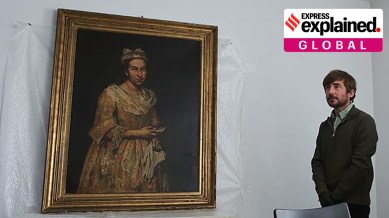Portrait of a Lady: How a real estate listing led to lost painting looted by Nazis
The large gold-framed portrait was presented in the coastal city of Mar del Plata, its first appearance in public in 80 years.

A federal court in Argentina on Wednesday announced the recovery of the Portrait of a Lady, an 18th-century painting by the Italian master Giuseppe Ghislandi, which was looted by the Nazis during World War II. The large gold-framed portrait was presented in the coastal city of Mar del Plata, its first appearance in public in 80 years.
A colour photo of the artwork surfaced last month in an online real estate listing unwittingly posted by Patricia Kadgien, whose father, Friedrich, had been a top adviser to Hermann Göring, among Adolf Hitler’s closest aides, who plundered thousands of works from across Europe.
“We’re doing this simply so that the community to whom we partly owe the discovery of the work…can see these images,” federal prosecutor Daniel Adler said in a press conference to display the full-length portrait dated to the early 18th century.
Discovery of the painting
On August 25, the Dutch newspaper Algemeen Dagblad (AD) reported that it had located the painting in a picture in a real estate listing online, which showed it hanging above a green couch in a living room. The listing, which has since been taken down, provided a breakthrough in AD’s long-running investigation into Kadgien.
The painting was not found during a raid on the property that followed the publication of the report, but two other paintings, believed to date to the 19th century, and several drawings were discovered. The court is in the process of determining whether these works too were looted during the war.
Prosecutors subsequently said that the Ghislandi had been returned by Patricia Kadgien’s lawyer. The woman, one of the two daughters of the former Nazi official, and her husband have been put under house arrest. They will face a hearing on Thursday on charges of concealment of the stolen artwork and obstruction of justice.
The story of the painting
The painting belonged to Jacques Goudstikker, a well-known Dutch-Jewish art dealer, and had long been on Dutch and international lists of missing artworks. The Nazis had forced Goudstikker to sell his gallery to Göring and his banker Alois Miedl.
After the defeat of the Third Reich, several high-ranking Nazis fled to South America using escape routes called ‘ratlines’. Kadgien was among them, fleeing from the Netherlands in 1946, first to Switzerland, then Brazil, and finally Argentina, AD reported. He died in Buenos Aires in 1978.
The AD article said Goudstikker’s descendants planned to stake claim to the painting. Goudstikker had recorded his inventory of about 1,400 artworks in a black notebook that he carried when he fled Nazi-occupied Netherlands in 1940 with his wife and son. He died on a cargo ship bound for England, but his widow retained the notebook.
Ariel Bassano, an art expert who worked on the case, said that the painting was “in good condition for its age, as it dates from 1710”, and valued it at “around $50,000”, the La Capital Mar del Plata newspaper reported. — WITH AGENCIES INPUTS